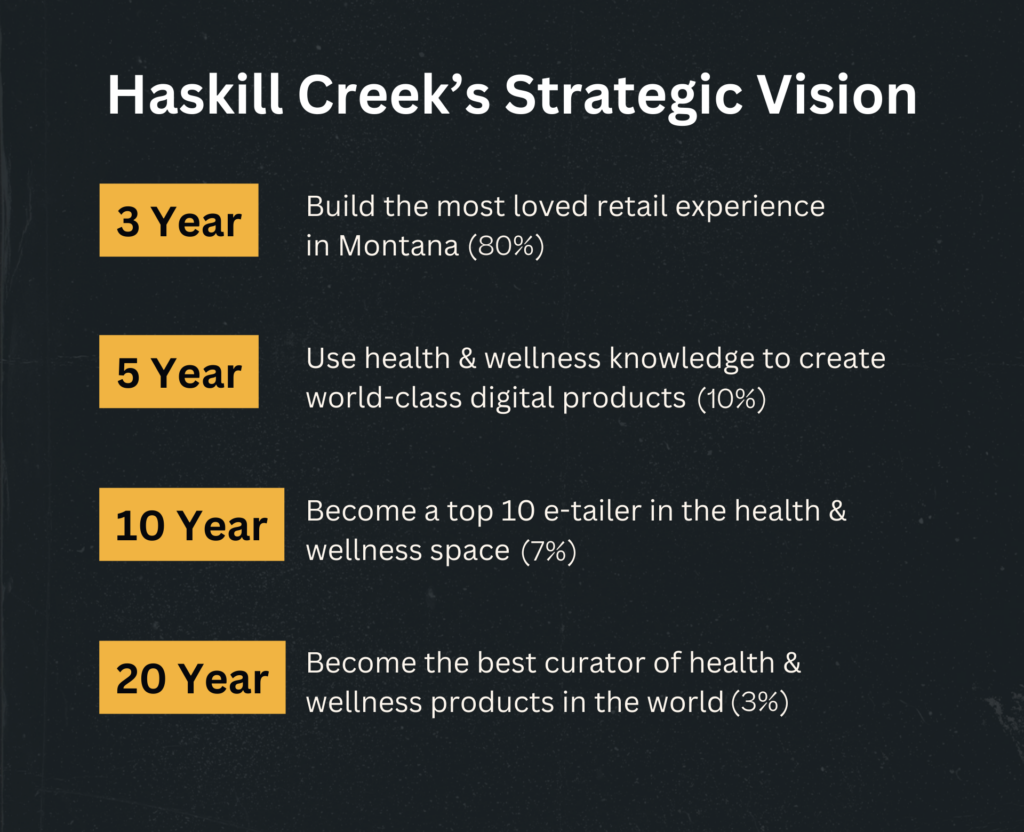
Better yet, can your entire team answer this question in the same way?
Where are we going?
Sounds simple, but 99% of teams answer this question in two ways:
Old-school business leaders would point to a vision statement to answer this question. But that misses the mark in so many ways.
In this post, we’ll dive into how to create an inspiring vision that people actually want to follow. And, after 20 years of trial and error, I finally found a format that nails it. At the end, I’ll give you a template that you can copy for your own company.
Ready? Here we go…
At the most basic level, a vision is how you see the future.
A company vision is how you see the future for the company and its customers.
Most people limit this to a simple one-sentence vision statement. But this is usually so high-level it loses its effectiveness. It’s also easily confused with the mission statement (see below).
Even Jim Collins, famous business author (who I normally agree with btw), confuses vision. He defines vision as:
Jim’s Definition: Vision = organization’s mission + values + long-term goals.
But this is mixing way too many concepts into one. My litmus test is this: if the team can’t use the company vision as a way to answer the question, where are we going… then it’s useless.
Defining vision as the mission, values and long-range goals all in one is not clarifying at all. Sorry, Jim.
My definition: Vision = the company outcomes you want to see in 3, 5, 10, and 20 years.
This definition can act as directional guidance for the entire team. And the organization can easily create annual goals that ladder to this vision.
A company vision is the journey to your North Star, providing clear direction toward a desired outcome.
Despite its importance, many companies are currently operating without one, but that’s a mistake. It’s like steering a ship without a rudder.
If you do a Google search, it’ll likely leave you with even more questions.
Are mission and vision the same?
What exactly makes them different?
I explained the difference between the two in this article, but it’s never a bad time for a refresher.
The simplest way to differentiate mission and vision is knowing what question each answers while also understanding how they work together to drive your business forward.
A mission statement answers the question, “Why do we exist?” It’s THE guiding light for the business. It’s forever pursued but likely never achieved. It should be relevant in 100 years.
Your company vision answers the question, “Where are we going?” and maps the steps (or milestones) you must achieve to get closer to your mission.
It’s critical for both to be in alignment, where the mission statement is the North Star and the vision is your star chart – mapping out your points along the way.
I started a company at 24, and it wasn’t long before I realized I had a vision problem. It’s not that I didn’t have a vision for the company… far from it, actually.
The problem was my vision wasn’t clear to my team. I thought I was dialed in, and they thought I was all over the place. I mistook clarity in my head for clarity of communication.
So, I came up with the 1-4 method so this wouldn’t happen again.
The “one-four” method stands for: One slide, four sentences.
By following this method, you’ll be able to clearly communicate your company vision while also building out a sequence to support your business evolution.
This method gives you one powerful slide that’ll help your team:
Remember, with most things in life and business, keep it simple, stupid!
Here’s how to build out your slide in 4 steps:
Start by creating a one-slide presentation in whatever app you use internally – Powerpoint, Google Slides, Typeset (this is a pretty cool slide generator using AI), etc.
On the top of the slide, write: [Your company’s name]’s Strategic Vision
We’re calling it a strategic vision because the 1-4 method has sequence to it and communicates an overarching strategy.
In the next steps, you’ll create four power sentences describing your vision in 3, 5, 10, and 20 years, where each sentence builds off the next.
The first of your four sentences is your 3-year vision and can be written underneath the slide title like this:
3-year: [your vision for your company] (80%)
In this example, “3-year” is the time frame, and “80%” is the resource allocation dedicated to this particular line. I’ll explain the resource allocation part below… don’t worry about it for now.
Now, fill in the [brackets] with your first vision sentence. I suggest making your 3-year vision statement about your target market. That could look something like this:
Build the best [X product] for [Y target audience]
Become the #[X] company in the [Y target market]
Become the most customer-loved company in the [Y target market]
And then…
Once you’ve perfected your 3-year company vision, it’s time to look ahead and write your 5, 10, and 20-year vision sentences.
You will revisit these and adjust with your company’s growth, but it’s a really powerful motivator to look that far in the future.
Add these single sentences underneath your 3-year vision like this:
5-year: [your second statement] (10%)
10-year: [your third statement] (7%)
20-year: [your fourth statement] (3%)
Dream bigger and bigger outcomes the further out you get – customer impact, market expansion, new product lines, etc.
Here’s an example of what your final slide might look like (from one of my companies):

The slide reads like this:
In 3 years, we’re going to build the most-loved retail experience in Montana…
And right now, we’re dedicating ~80% of our resources toward this 3-year vision.
In 5 years, we’re going to use health and wellness knowledge to create world-class digital products.
And when we get there, we will dedicate ~10% of our resources to this 5-year vision.
In 10 years, we will become a top 10 e-tailer in the health and wellness space.
And when we get there, we will dedicate ~7% of our resources to this 10-year vision.
In 20 years, we will become the best curator of health and wellness products in the world.
And when we get there, we will dedicate ~3% of our resources to this 20-year vision.
The percentages represent an approximate resource allocation. For example, by putting 80% on the slide, I’m saying that 80% of the company’s resources will be dedicated to achieving the first line on this vision slide. Extending this further, 10% of our resources will be dedicated to the 5-year line, and so on.
This will help your team better understand how to spend their time but also gives them permission to dedicate some time to the bigger picture long-range vision.
Company growth is far from linear, so it’s important to revisit your 1-4 vision slide every year and adjust accordingly.
90% of the time, nothing will change, but take some time to make any tweaks that better fit the stage of your business growth and adjust the resource allocations if you over- or under-shot with your initial projections.
At the end of three years, it’s time to do a bigger update. Roughly 75% of your slide should roll over, but you’ve outgrown your initial 3-year statement. This is a great time for a major launch within the company
Access my 1-4 method template to copy for your company.
Now that you’re thinking about vision differently, here are a few closing notes:
So now you know how to write a mission statement that doesn’t suck and a vision people actually want to follow, what’s next?
You’re well on your way to building a business that can last forever…
But there’s always something new to learn and undiscovered opportunities for personal and professional growth.
Are you a founder, executive, or manager? I’d love to support your professional growth.
Here are three ways:
Join 100,000+ leaders getting the blueprint to go from $0 to $100M.
If you watch one thing this week, this should be it 👇 Ever feel like you’re working your ass off, but not making any real progress? It happens to the best of us. In the...
Culture | May 24, 2024
Culture is a lagging indicator Culture is the heart of any strong company. When you get it right, it’s like a magnet for positive progress – it’ll attract great people, great customers, and new ideas....
Founders, Leadership | May 17, 2024
It’s all about incentive alignment… Most companies screw up compensation design. They struggle to balance base pay, bonus pay, and sales commissions – either making things too complex (you need a PHD to understand your...
I'd love to learn more about you to better customize the tips I send, ensuring they are as relevant and helpful as possible.


Hi, I’m Scot — Join 100,000+ leaders getting
the blueprint to go from $0 to $100M.